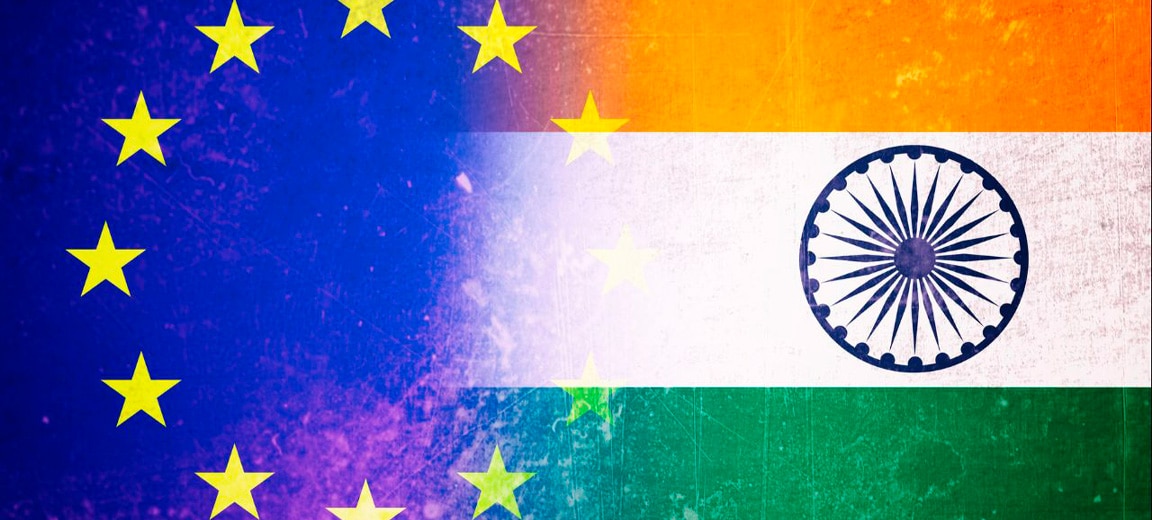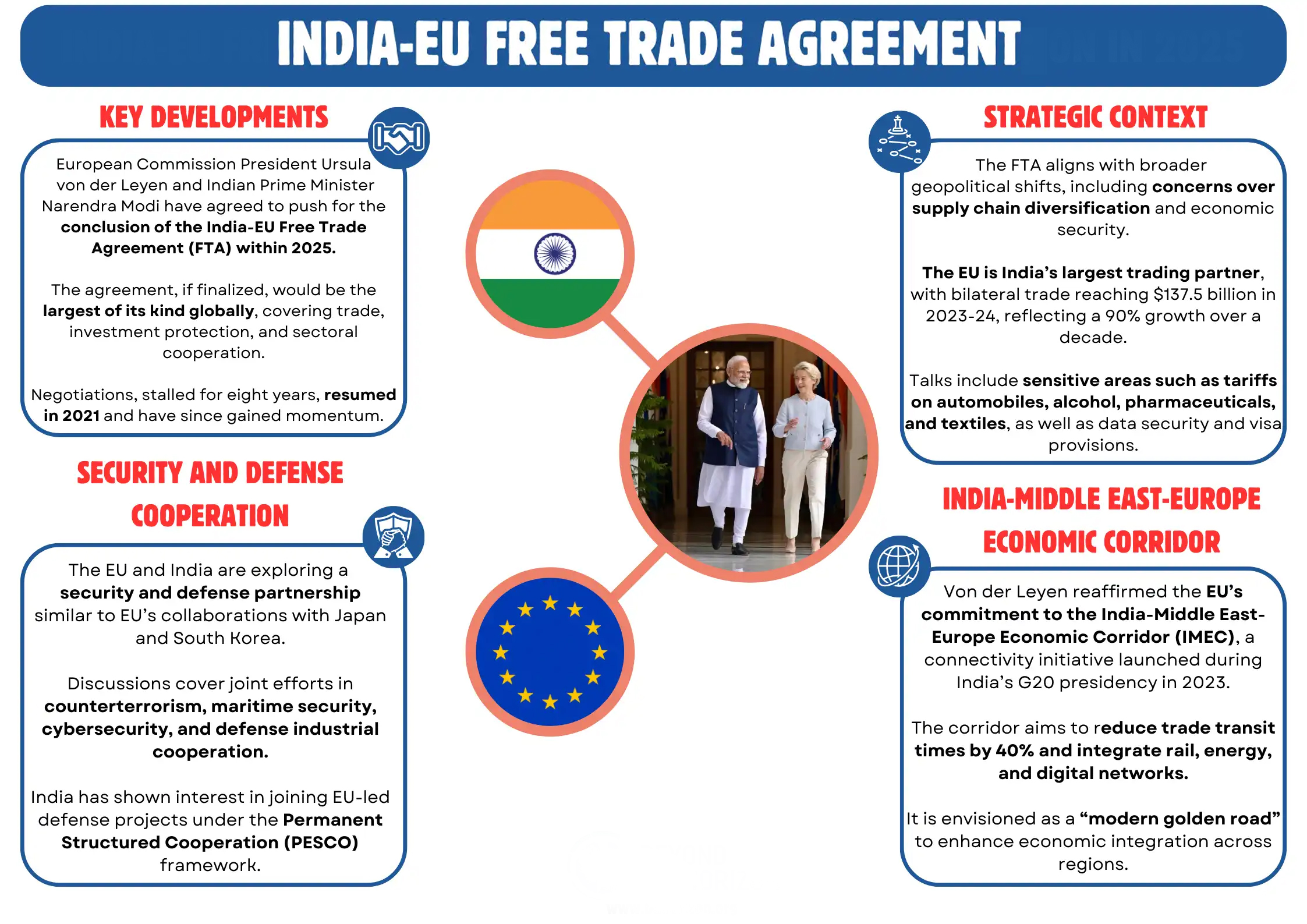Context:
In an era of shifting global alignments, the relationship between India and the European Union (EU) has gained fresh significance. The unpredictability in U.S. foreign policy under President Donald Trump highlighted the need for stable partnerships, and Europe is positioning itself as a reliable, “all-weather” friend of India.
-
-
- The upcoming India–EU Leaders’ Summit, scheduled for February 2026, is expected to consolidate this growing engagement. In preparation, both sides are holding weekly discussions across sectors. Ahead of the summit, the EU released a document presenting a New Strategic Agenda for India–EU relations, organised around five pillars: Economy and Trade, Connectivity, Emerging Technologies, Security and Defence, and People-to-People Ties.
- The upcoming India–EU Leaders’ Summit, scheduled for February 2026, is expected to consolidate this growing engagement. In preparation, both sides are holding weekly discussions across sectors. Ahead of the summit, the EU released a document presenting a New Strategic Agenda for India–EU relations, organised around five pillars: Economy and Trade, Connectivity, Emerging Technologies, Security and Defence, and People-to-People Ties.
-
Pillar 1: Economy and Trade:
-
-
-
- The EU is India’s largest trading partner, and India is the EU’s biggest partner in the Global South.
- Bilateral trade in goods reached €120 billion in 2024, nearly 90% higher than a decade earlier.
- Services trade adds another €60 billion.
- Around 6,000 European companies operate in India, employing 3 million people directly and supporting millions more indirectly.
- EU foreign direct investment (FDI) into India stood at €140 billion in 2023, almost double the figure five years earlier.
- The EU is India’s largest trading partner, and India is the EU’s biggest partner in the Global South.
-
-
However, India still accounts for less than 2.5% of the EU’s overall trade, and Indian investments in the EU remain limited at €10 billion.
Future Plans:
-
-
-
- Conclude a Free Trade Agreement (FTA) by the end of 2025, expected to be one of the largest trade deals globally.
- Finalise an Investment Protection Agreement (IPA), a Geographical Indications (GI) agreement, a bilateral macroeconomic dialogue, and a comprehensive air transport agreement.
- Expand supply chains and investment flows by reducing tariff and non-tariff barriers.
- Conclude a Free Trade Agreement (FTA) by the end of 2025, expected to be one of the largest trade deals globally.
-
-
Pillar 2: Connectivity and Global Issues:
Key Projects
-
-
-
- India–Middle East–Europe Economic Corridor (IMEC): Revives historical trade routes with integrated maritime, rail, energy, digital, and clean hydrogen infrastructure.
- EU–Africa–India Digital Corridor: Includes the 11,700 km Blue Raman submarine cable system, linking Europe and India through the Mediterranean, Middle East, and East Africa. It offers ultra-high-speed, secure, and disaster-resilient data connectivity.
- Green Shipping Corridors: Promote sustainable maritime connectivity and reduce carbon-intensive trade routes.
- India–Middle East–Europe Economic Corridor (IMEC): Revives historical trade routes with integrated maritime, rail, energy, digital, and clean hydrogen infrastructure.
-
-
Multilateral Role:
Pillar 3: Emerging Technologies and Innovation
Proposals and Initiatives:
-
-
-
- Establish EU–India Innovation Hubs on critical technologies, linking policymakers, industries, startups, and investors.
- Launch an EU–India Startup Partnership with Start-up India, the European Innovation Council, and member states.
- Focus on artificial intelligence (AI):
- Large language models
- Multilingual natural language datasets
- AI training datasets
- AI for healthcare, agriculture, and climate action
- Large language models
- Develop measures to prevent unauthorised transfer or misuse of sensitive technologies, ensuring responsible innovation.
- Expand nuclear cooperation under the Euratom–India agreement, covering nuclear reactor safety, waste management, nuclear security, and nuclear fusion.
- Establish EU–India Innovation Hubs on critical technologies, linking policymakers, industries, startups, and investors.
-
-
Pillar 4: Security and Defence:
Areas of Cooperation
-
-
-
- Maritime security, cybersecurity, counterterrorism, and non-proliferation.
- Negotiations on a Security of Information Agreement, enabling classified data exchange.
- Possible EU–India Security and Defence Partnership.
- Coordination between the EU Naval Force and Indian Navy in the western Indian Ocean.
- Joint efforts against terrorism, terror financing, online propaganda, and drug trafficking.
- Maritime security, cybersecurity, counterterrorism, and non-proliferation.
-
-
Defence Industrial Cooperation
· Strengthening India’s defence base through Europe’s research and manufacturing expertise.
· Promoting innovation and resilient supply chains under Make in India.
· Proposal for an EU–India Defence Industry Forum to connect businesses, share best practices, and co-develop technologies.
Pillar 5: People-to-People Ties
-
-
-
- In 2023, about 825,000 Indians lived in the EU, making them the largest group receiving Blue Cards and intra-corporate transfer permits.
- Nearly one million Schengen visas were issued in India in 2024, many for multiple entries.
- In 2023, about 825,000 Indians lived in the EU, making them the largest group receiving Blue Cards and intra-corporate transfer permits.
-
-
Priorities
· Manage migration by curbing illegal flows while promoting balanced talent mobility.
· Expand academic and research exchanges through Erasmus and the Union of Skills.
· Work towards mutual recognition of qualifications and joint programmes, encouraging European universities to attract Indian talent.
· Establish joint vocational education initiatives, satellite campuses, and language training in India.
Significance of India–EU Relations:
-
-
-
- Diplomatic History: Relations began with the European Economic Community in 1962; upgraded to a Strategic Partnership in 2004.
- Trade Partnership: The EU is India’s second-largest trading partner, accounting for 11.5% of its trade (€120 billion).
- Strategic Alignment: Shared interests in renewable energy, multilateralism, maritime security, counterterrorism, and human rights.
- Technology and Supply Chains: Cooperation through the India–EU Trade and Technology Council (TTC) in semiconductors, AI, clean energy, and digital finance.
- Global Governance: Both support a rules-based order in the UN, WTO, and G20, while diversifying away from reliance on China.
- Diplomatic History: Relations began with the European Economic Community in 1962; upgraded to a Strategic Partnership in 2004.
-
-
Significance for India:
-
-
-
- EU is India’s ninth-largest partner (2.4% of EU trade, 2024).
- FDI inflows from the EU to India were USD 107.27 billion (April 2000–December 2023).
- Boosts India’s industrial growth, job creation, and technology transfer.
- Expands export opportunities in IT, pharma, textiles, and agriculture.
- European defence firms support Indian modernisation projects (e.g., Airbus C-295 aircraft production in India).
- TTC cooperation enhances India’s edge in semiconductors, AI, clean energy, fintech, and digital payments.
- EU is India’s ninth-largest partner (2.4% of EU trade, 2024).
-
-
Significance for the EU:
-
-
-
- Access to India’s large and growing market.
- Gains from India’s young and skilled workforce, enriching Europe’s talent pool.
- Strategic benefits from India’s Indo-Pacific position, ensuring influence in the Global South.
- Indian Ocean security is vital, with 35% of Europe–Asia trade passing through these waters.
- Access to India’s large and growing market.
-
-
Major Challenges:
-
-
-
- Stalled FTA Talks: EU seeks tariff cuts on automobiles, spirits, and dairy; India wants access for IT services and pharmaceuticals.
- Carbon Border Adjustment Mechanism (CBAM): Raises costs for Indian exporters.
- Regulatory Barriers: EU’s technical standards and SPS measures restrict Indian exports.
- Investment Concerns: European investors want stronger IP protections and predictable policies. Switzerland even suspended the MFN clause in its tax treaty with India.
- Data Privacy: India lacks EU data adequacy status, raising compliance costs for IT exporters.
- Foreign Policy Divergence: India’s oil imports from Russia and participation in Russian military exercises complicate EU expectations on sanctions.
- Supply Chain Risks: Dependence on China continues for both regions, exposing them to geopolitical disruptions.
- Stalled FTA Talks: EU seeks tariff cuts on automobiles, spirits, and dairy; India wants access for IT services and pharmaceuticals.
-
-
Conclusion:
The New Strategic Agenda reflects the maturing of India–EU ties into a comprehensive, multi-dimensional partnership. With five pillars covering trade, connectivity, technology, defence, and people-to-people cooperation, the framework seeks to unlock untapped potential in economic growth, innovation, and global governance.
| UPSC/PSC Main Question: India’s partnership with the EU can strengthen its position in the Indo-Pacific and diversify its global engagements beyond the US and China.” Discuss. |








